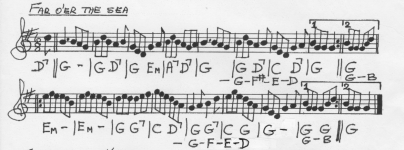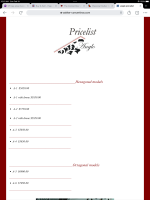Walker
🪗
Last night I was reading a little about the concertina, and what I discovered was fascinating. What a wonderful little instrument it is! Compact and light but with a sound that echoes the ages gone by... The three types of concertina I read about were the Anglo, the English and the Duet.
Each has it's own particular charms. The Anglo being popular in Irish traditional music and English Morris, is diatonic and bisonoric in design, giving a lift to dance tunes. Then there's the unisonoric and chromatic English concertina that is also a great "melody" instrument. It seems that both hands share the burden of creating the melody on these instruments as the "treble" notes are spread over both sides (especially on English Concertina). Some forms of harmony are possible on these instruments. However, there is something slightly different about the Duet Concertina. The right hand creates the higher treble notes and the left hand creates the lower notes (also a characteristic of the Anglo instrument). The Duet is very much like a free bass accordion or piano, and has a polyphonic & harmonising nature.
I like these instruments very much. There is something quite liberating about the Concertina. You don't have to worry about multiple voices, converter switches, cassotto or having the best part of 12 to 14kg sat on your lap. It's okay to play simple beautiful melodies, (whereas on an accordion or bayan many people often want a firework display of virtuosity). Plus the concertina seems to be less expensive than the 'price of a car' accordion. I believe the likes of the Charles Wheatstone Concertina also hold their value well too, but I am no expert on this.
Whilst the piano accordion is my main instrument, I just wonder if the concertina could be the next instrument on the list...
Duet Concertina, playing Scottish traditional air
English Concertina, playing old English folk tunes
Anglo Concertina, playing Irish traditional music
The Duet Concertina comes with many different system layouts, such as Maccann, Crane, Jeffries and Hayden (and many more). The system that is most used on modern Duet instruments nowadays is the Hayden system. It has a fantastic treble and bass layout that makes strong use of the circle of fifths (stradella or quint as we might call it ), whole tones & octaves intervals. It is considered an isomorphic system. I have a leaning towards the Duet Concertina with Hayden system, but think they (Anglo, English and Duet concertinas) are all excellent in their own right.
), whole tones & octaves intervals. It is considered an isomorphic system. I have a leaning towards the Duet Concertina with Hayden system, but think they (Anglo, English and Duet concertinas) are all excellent in their own right.
Each has it's own particular charms. The Anglo being popular in Irish traditional music and English Morris, is diatonic and bisonoric in design, giving a lift to dance tunes. Then there's the unisonoric and chromatic English concertina that is also a great "melody" instrument. It seems that both hands share the burden of creating the melody on these instruments as the "treble" notes are spread over both sides (especially on English Concertina). Some forms of harmony are possible on these instruments. However, there is something slightly different about the Duet Concertina. The right hand creates the higher treble notes and the left hand creates the lower notes (also a characteristic of the Anglo instrument). The Duet is very much like a free bass accordion or piano, and has a polyphonic & harmonising nature.
I like these instruments very much. There is something quite liberating about the Concertina. You don't have to worry about multiple voices, converter switches, cassotto or having the best part of 12 to 14kg sat on your lap. It's okay to play simple beautiful melodies, (whereas on an accordion or bayan many people often want a firework display of virtuosity). Plus the concertina seems to be less expensive than the 'price of a car' accordion. I believe the likes of the Charles Wheatstone Concertina also hold their value well too, but I am no expert on this.
Whilst the piano accordion is my main instrument, I just wonder if the concertina could be the next instrument on the list...
Duet Concertina, playing Scottish traditional air
English Concertina, playing old English folk tunes
Anglo Concertina, playing Irish traditional music
The Duet Concertina comes with many different system layouts, such as Maccann, Crane, Jeffries and Hayden (and many more). The system that is most used on modern Duet instruments nowadays is the Hayden system. It has a fantastic treble and bass layout that makes strong use of the circle of fifths (stradella or quint as we might call it
Last edited:



